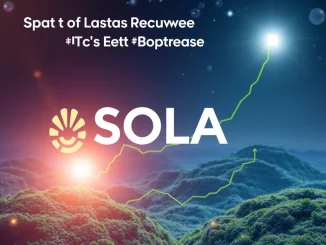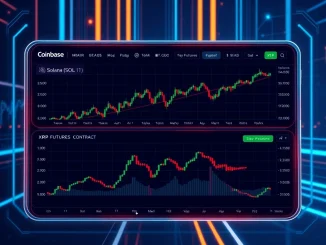
In a move closely watched by the crypto community, Solana’s proposal to drastically reduce SOL inflation, known as SIMD-0228, has unfortunately failed to secure the necessary validator approval. This news has sent ripples through the Solana ecosystem, prompting discussions about the future of SOL tokenomics and network governance. For SOL holders and Solana enthusiasts, understanding what happened and what it means is now more important than ever. Let’s dive into the details of this pivotal vote and explore its implications.
Why Solana Inflation Matters
Before we delve into the specifics of the failed proposal, it’s essential to understand why Solana inflation is a significant topic. Like many proof-of-stake blockchains, Solana utilizes inflation to incentivize validators to secure the network and participate in block production. However, the rate of inflation can have a profound impact on the value of the SOL token and the overall health of the Solana ecosystem. High inflation can lead to:
- Token devaluation: As the supply of SOL increases due to inflation, it can dilute the value of existing tokens if demand doesn’t keep pace.
- Reduced staking rewards APY: While inflation creates staking rewards, excessive inflation can diminish the real yield for stakers after accounting for the inflationary pressure.
- Economic uncertainty: Unpredictable or excessively high inflation can create uncertainty and hinder long-term investment in the Solana network.
Conversely, a well-managed inflation rate can ensure network security, incentivize participation, and foster a sustainable economic model. This is why the Solana proposal to adjust inflation was met with such keen interest.
SIMD-0228: A Bold Move to Curb SOL Inflation
The SIMD-0228 proposal aimed to aggressively tackle SOL inflation by implementing a substantial 80% reduction. This was a significant adjustment that, if approved, would have dramatically altered Solana’s tokenomics. The proposal was put forward with the intention of:
- Enhancing SOL’s scarcity: By significantly reducing inflation, the proposal sought to make SOL a more scarce asset over time, potentially increasing its value.
- Attracting long-term investors: Lower inflation could make SOL more appealing to investors looking for assets with sound monetary policy.
- Shifting focus to transaction fees: Reducing reliance on inflation could push the network towards a model where transaction fees play a more prominent role in validator compensation.
The proposed change reflected a growing sentiment within the Solana community to prioritize long-term value appreciation of SOL and move towards a more sustainable economic model less dependent on high inflationary rewards.
Validator Voting: The Decisive Factor
For any significant change to be implemented on the Solana network, it requires a consensus from its validators. This is where validator voting comes into play. Validators are responsible for securing the network, validating transactions, and participating in governance decisions. SIMD-0228 was put to a vote among Solana’s active validators, requiring a supermajority of 66.67% approval to pass.
Let’s break down the voting statistics, as reported by SIMD Vote Status and Dune Analytics:

Solana Validator Voting Results for SIMD-0228
Key Voting Statistics:
| Metric | Value |
|---|---|
| Validators Participating | 910 (68% of active validators) |
| Total Active Validators | 1,334 |
| Votes in Favor | 61.39% |
| Votes Against | 27.4% |
| Abstentions | 3.3% |
| Approval Threshold | 66.67% |
| Proposal Status | Failed |
As the data clearly indicates, while a significant majority (61.39%) of the votes cast were in favor of reducing inflation, it fell short of the crucial 66.67% threshold required for approval. This outcome highlights a division within the validator community regarding the optimal path forward for Solana’s tokenomics.
Why Did the Solana Proposal Fail?
Several factors might have contributed to the failure of the Solana proposal. Understanding these reasons is crucial for future governance discussions and proposals:
- Validator Disagreement: The voting results reveal a substantial portion of validators (over 30% when combining ‘against’ and ‘abstain’) were not convinced by the proposal. This could stem from differing views on the ideal inflation rate, concerns about the immediate impact on staking rewards, or a preference for the status quo.
- Lack of Consensus Building: Perhaps the proposal lacked sufficient pre-vote discussion and consensus-building among validators. Effective governance often requires thorough communication and addressing concerns before a formal vote.
- Short-Term vs. Long-Term Perspectives: Some validators might prioritize short-term staking rewards and network security incentivized by higher inflation, while others might focus on the long-term value appreciation of SOL through reduced inflation. This difference in perspective could have led to the split vote.
- Uncertainty about Impact: Predicting the precise impact of such a significant inflation reduction is challenging. Some validators might have been hesitant to support a drastic change without complete certainty about its consequences on network security and economic stability.
What’s Next for SOL Inflation and Solana?
With the SIMD-0228 proposal failing, SOL inflation will continue at its current rate. However, this is unlikely to be the end of the discussion. The strong support for the proposal (over 60% of votes) indicates a clear desire within the community to address inflation concerns. Looking ahead, we can expect:
- Continued Dialogue: The Solana community and developers will likely continue to discuss and explore different approaches to managing inflation. This failed vote could serve as a catalyst for more in-depth discussions and refined proposals.
- Revised Proposals: We may see revised inflation reduction proposals in the future, potentially with adjustments to address validator concerns and build broader consensus. These might involve a more gradual reduction in inflation or alternative mechanisms to balance network security and token value.
- Focus on Other Economic Levers: Solana may explore other economic levers beyond inflation to enhance SOL’s value and incentivize network participation. This could include focusing on increasing transaction volume, attracting more applications and users to the network, and further developing its DeFi ecosystem.
- Community Engagement: Increased community engagement and education around tokenomics and governance will be crucial for future successful proposals. Ensuring validators and SOL holders are well-informed and have opportunities to voice their opinions is vital.
Conclusion: A Setback, Not a Dead End
The failure of the Solana inflation reduction proposal is undoubtedly a setback for those who advocated for a more aggressive approach to managing SOL inflation. However, it’s important to view this as a part of the decentralized governance process. The validator vote reflects a nuanced perspective within the Solana network, highlighting the complexities of balancing competing priorities and achieving consensus. The conversation around Solana’s tokenomics is far from over, and this event may ultimately pave the way for more robust and widely supported solutions in the future. The Solana community remains resilient and innovative, and the ongoing dialogue about its economic model is a testament to its commitment to long-term sustainability and growth.



